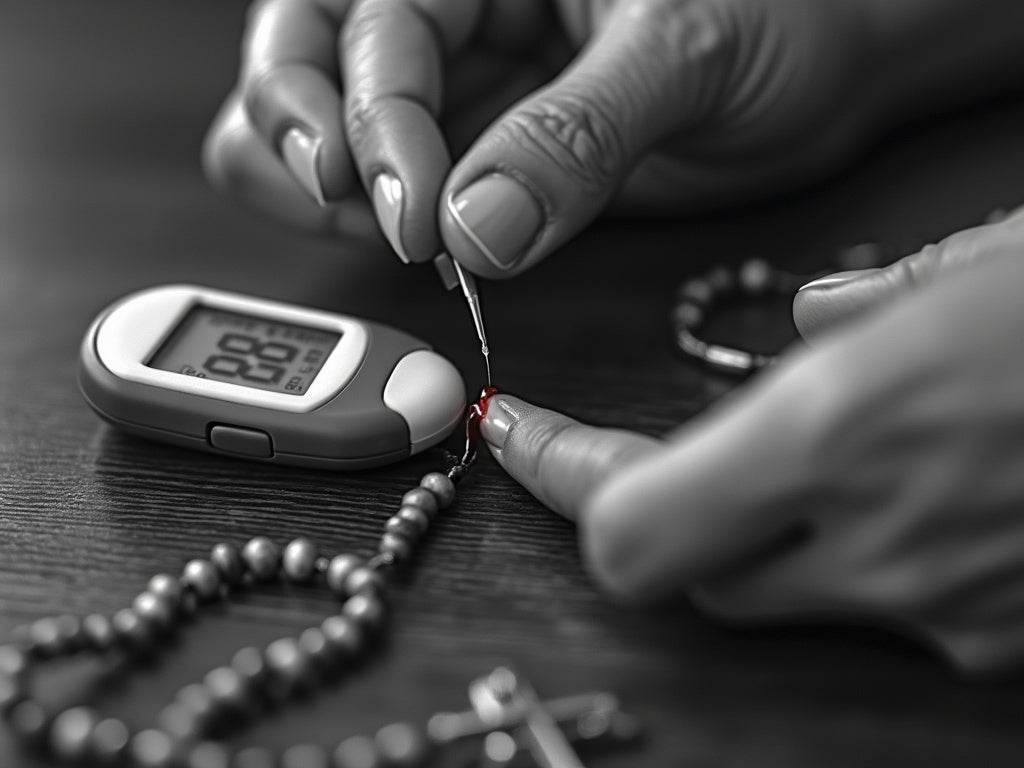
Master Sugar Levels: 7 Tips for Healthy Blood Sugar
Share
Understanding and managing sugar levels is crucial for overall health and well-being. By mastering the art of blood sugar control, you can reduce your risk of chronic diseases and improve your quality of life through simple yet effective lifestyle changes.
Key Takeaways:
- Healthy blood sugar ranges are essential for preventing diabetes and other health issues
- Diet, exercise, and stress management play vital roles in maintaining stable glucose levels
- Regular monitoring and recognizing symptoms of blood sugar imbalances are crucial
- Implementing seven key strategies can help you maintain optimal sugar levels
- Consistent blood sugar management reduces the risk of long-term health complications
Understanding Blood Sugar: The Key to Health
Sugar levels, also known as blood glucose levels, play a critical role in our health. They serve as a primary energy source for our body's cells and organs. Maintaining healthy blood sugar is essential for preventing chronic diseases like diabetes and ensuring overall well-being.
A healthy blood sugar range is typically defined as follows:
- Normal fasting blood sugar: 70-99 mg/dL
- Normal postprandial (two hours after eating): below 140 mg/dL
- A1C (long-term average): Below 5.7% is normal, 5.7%-6.4% is prediabetic, and 6.5%+ indicates diabetes
Regular monitoring of blood sugar is crucial for early detection and prevention of diabetes. According to recent statistics, approximately 37.3 million adults in the U.S. are managing diabetes or prediabetes. This highlights the importance of understanding blood sugar levels and taking proactive steps to maintain them within a healthy range.

Factors Influencing Blood Sugar Levels
Several factors can impact your blood glucose variation. Understanding these can help you better manage your sugar levels:
- Diet: High-carb foods can cause blood sugar spikes, while whole foods tend to minimize them.
- Physical Activity: Regular exercise helps stabilize blood sugar levels. Studies show that consistent physical activity can reduce fasting blood sugar by almost 10%.
- Stress and Hormones: Stress hormones like cortisol can raise sugar levels.
- Illness and Medications: Certain drugs or infections can alter glucose levels.
Insulin plays a crucial role in regulating blood sugar. It helps cells absorb glucose from the bloodstream, effectively lowering blood sugar levels. Understanding the relationship between insulin and blood sugar fluctuations is key to maintaining healthy glucose levels.
Recognizing Unhealthy Blood Sugar Symptoms
Being able to identify the signs of unhealthy sugar levels is crucial for timely intervention. Let's look at the symptoms of both high and low blood sugar:
Hyperglycemia (High Blood Sugar):
- Symptoms: Fatigue, blurred vision, excessive thirst, frequent urination
- Ranges: Above 140 mg/dL can worsen to 200+ mg/dL if untreated
Hypoglycemia (Low Blood Sugar):
- Symptoms: Dizziness, sweating, shakiness, confusion
- Defined as levels below 70 mg/dL (or below 54 mg/dL in extreme cases)
It's important to note that severe hyperglycemia can lead to a coma, while hypoglycemia may cause fainting or seizures. Recognizing these glucose levels warning signs early can prevent serious health complications.
7 Tips for Maintaining Healthy Sugar Levels
Implementing these seven strategies can help you maintain optimal blood sugar levels:
- Healthy Diet Choices: Focus on low-GI foods, whole grains, and lean proteins. For instance, choose brown rice over white rice, and include plenty of vegetables in your meals.
- Regular Exercise: Include moderate-intensity exercises like brisk walking for at least 30 minutes a day, five days a week. This can significantly improve your body's insulin sensitivity.
- Monitor Regularly: Use glucose meters to test your sugar levels consistently. This helps you understand how different foods and activities affect your blood sugar.
- Stress Management: Practice yoga, meditation, or deep breathing exercises to lower cortisol levels. Even a 10-minute daily meditation can make a difference.
- Get Sufficient Sleep: Aim for 7-9 hours of quality sleep per night. Poor sleep can disrupt hormones that regulate blood sugar.
- Stay Hydrated: Drink at least 8 glasses of water daily. Proper hydration helps your kidneys flush out excess glucose through urine.
- Limit Alcohol Consumption: If you drink, do so in moderation. Alcohol can cause both spikes and drops in blood sugar levels.
By incorporating these blood sugar management strategies into your daily routine, you can effectively control your glucose levels and improve your overall health.
Frequently Asked Questions
1. What is a healthy blood sugar range for adults?
A healthy fasting blood sugar range for adults is 70-99 mg/dL. Two hours after eating, it should be below 140 mg/dL. For long-term blood sugar control, an A1C below 5.7% is considered normal.
2. What causes blood sugar to spike?
Blood sugar spikes can be caused by consuming high-carb or sugary foods, stress, lack of physical activity, certain medications, and illnesses. It's important to be aware of these factors and manage them effectively.
3. What happens if sugar levels are too low?
Low blood sugar, or hypoglycemia (below 70 mg/dL), can cause symptoms like dizziness, sweating, shakiness, and confusion. In severe cases (below 54 mg/dL), it can lead to fainting or seizures.
4. How often should I check my blood sugar?
The frequency of blood sugar checks depends on your health status. If you're managing diabetes or prediabetes, consult your healthcare provider for a personalized monitoring plan. Many individuals check their levels daily, especially around meals and physical activities.
5. Can diet alone regulate sugar levels?
While a balanced, low-glycemic diet is crucial for blood sugar control, it's most effective when combined with regular exercise, proper hydration, and stress management. A holistic approach yields the best results in maintaining healthy sugar levels.
6. What foods prevent blood sugar spikes?
Foods that help prevent blood sugar spikes include whole grains, low-GI foods (like oats, lentils, and non-starchy vegetables), lean proteins, and healthy fats such as those found in avocados or nuts. Apple cider vinegar has also been shown to have beneficial effects on blood sugar levels. It's best to avoid processed and sugary foods to minimize glucose fluctuations.
References
1. Healthline. Helping You Understand 'Normal' Blood Sugar Levels [Internet]. [cited 2023]. Available from: https://www.healthline.com/health/diabetes/normal-blood-sugar-level
2. Levels. What should your glucose levels be? The 2024 Levels Guide to healthy blood sugar ranges [Internet]. [cited 2023]. Available from: https://www.levels.com/blog/what-should-my-glucose-levels-be-ultimate-guide
3. Northeast Medical Group. What Is the Normal Range for Blood Sugar? [Internet]. [cited 2023]. Available from: https://www.northeastmedicalgroup.org/articles/what-is-healthy-blood-sugar
Sources:








